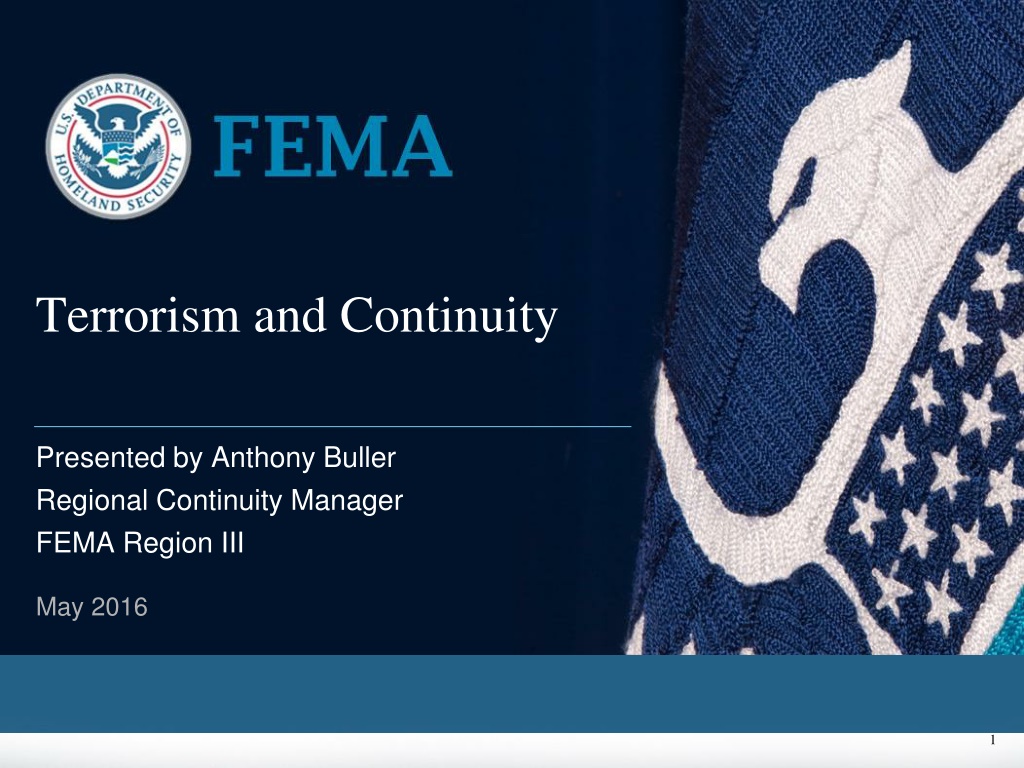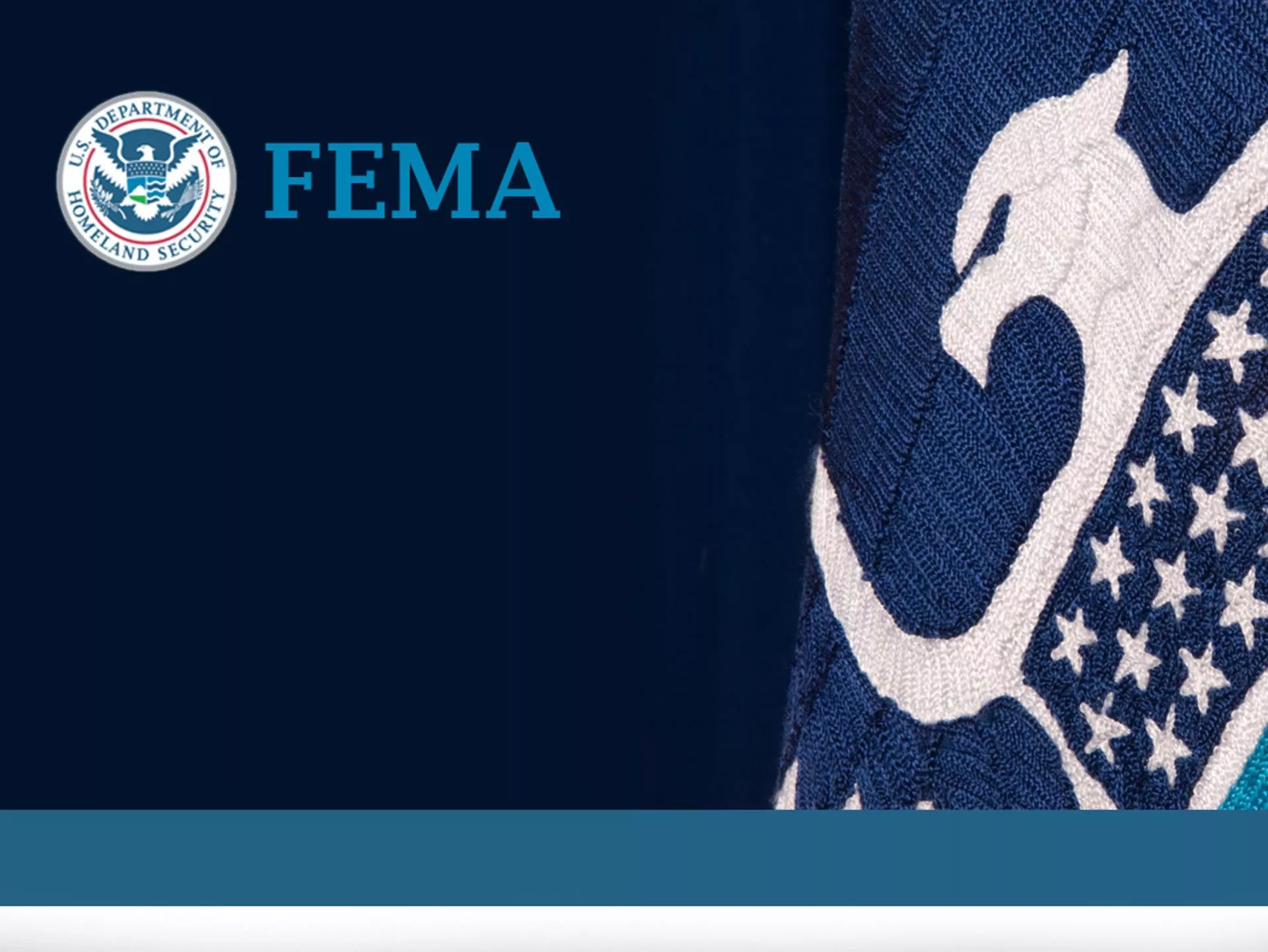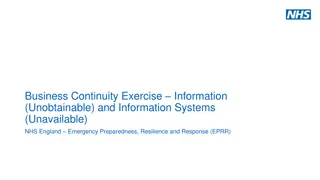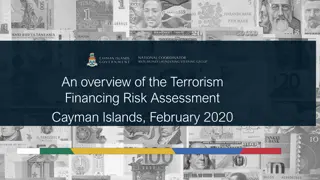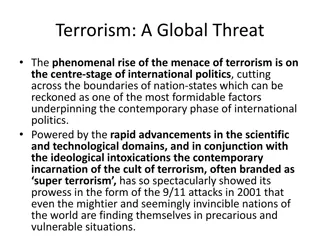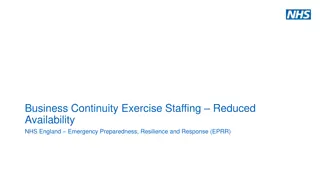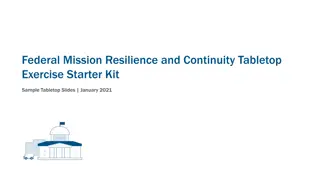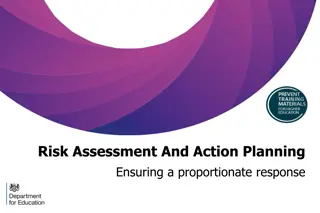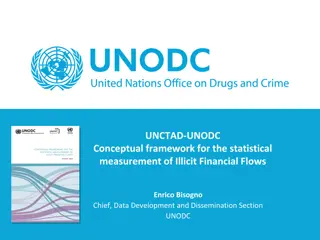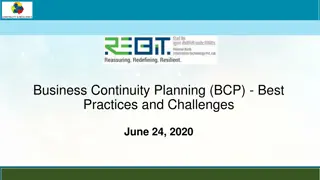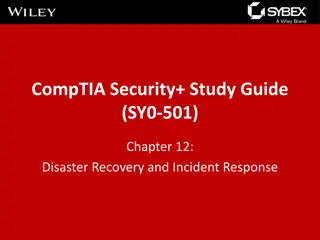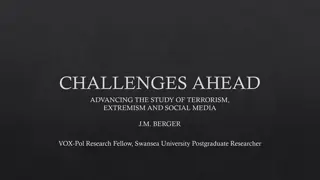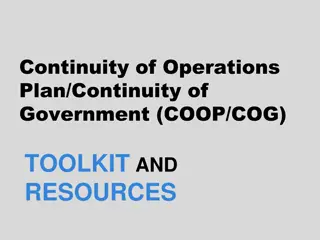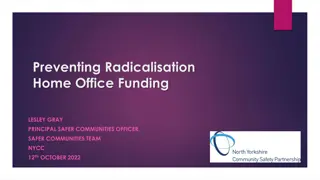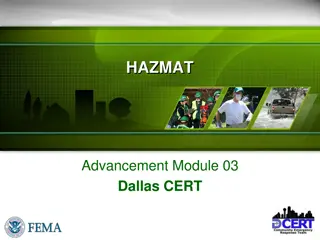Terrorism and Continuity Implications
This presentation delves into the implications of terrorism events on continuity of operations, addressing essential functions sustainment, facility issues, human resource challenges, devolution, and reconstitution. It covers key concepts, targets, and areas of interest related to terrorism preparedness and response.
Download Presentation

Please find below an Image/Link to download the presentation.
The content on the website is provided AS IS for your information and personal use only. It may not be sold, licensed, or shared on other websites without obtaining consent from the author.If you encounter any issues during the download, it is possible that the publisher has removed the file from their server.
You are allowed to download the files provided on this website for personal or commercial use, subject to the condition that they are used lawfully. All files are the property of their respective owners.
The content on the website is provided AS IS for your information and personal use only. It may not be sold, licensed, or shared on other websites without obtaining consent from the author.
E N D
Presentation Transcript
Terrorism and Continuity Presented by Anthony Buller Regional Continuity Manager FEMA Region III May 2016 1
Overview Scope and Purpose Concepts to Consider Targets Boston Marathon Bombing Continuity Planning Reconstitution Summary 2
Scope and Purpose The purpose of this briefing is to identify the possible implications of a terrorism event on Continuity of Operations There are a multitude of sources for information on emergency response to a terrorism event available through various Federal, State, and local agencies. The scope of this briefing is to address some of the continuity impacts and considerations such as: Essential functions sustainment Facility issues Human resource challenges Devolution Reconstitution 3
Concepts to Consider On September 16th, 2013 an active shooter incident occurred at the Navy Yard in Washington DC There was a feeling of powerlessness. I m in command of 60,000 people, and I can do nothing. I am locked down with my phone. Vice Admiral William Hilarides, Naval Sea Systems Command 4
Concepts to Consider Malicious intent, not random natural occurrence Fear of being targeted as an organization Running or moving does not necessarily reduce the threat Coordinated/Secondary attacks Unknown timeline, no clear end Ambiguous decision points on activation, relocation, or reconstitution 5
Whats Missing = Continuity Areas of Interest 7
Targets Anything can be a target Focus on likely targets and implications to mitigate the possible disruptions There are three broad categories of targets: Government assets Critical infrastructure Densely populated areas 8
Target: Government Assets Examples Government buildings Impact of Attack Direct victimization of government and response personnel and assets Symbolic value and associated psychological impact Continuity elements most impacted: Essential Functions Succession/Authorities Human Resources Alternate Facilities Essential Records Reconstitution Courts, jails, offices, parks Police and fire stations Transportation fleets Warehouses, telecommunications 9
Target: Critical Infrastructure Examples Power stations Impact of Attack Disruption to government and businesses due to dependencies Cascading consequences multiply the effect of single attack Continuity elements most impacted: Human Resources Continuity Communications Alternate Facilities Reconstitution Telecommunication lines Roads, bridges, train tracks Gas, water, sewer lines Food and agricultural sources 10
Target: Densely Populated Areas Examples Hotels, Restaurants, Malls Impact of Attack Potential for mass casualties Opportunistic attacks may seem random and produce widespread fear Long term economic impact Continuity elements most impacted: Human Resources Succession/Authorities Continuity Communications Test, Training, and Exercises Schools, Places of Worship Sporting and Entertainment Events General downtown areas 11
Boston Marathon Bombing Developing and Maintaining Pre-Existing Professional Relationships Enhances capacity and capabilities to respond to complex incidents in a manner that cannot tangibly be captured or addressed in a written plan Pre-existing professional relationships among key leadership and front-line personnel Planning for special events Training and exercising Experience with prior large-scale events Participation in Multi-Jurisdictional Exercises Enhances capabilities and proficiency to respond Practices response and coordination role and responsibilities Initial response to bombings was similar to 2012 tabletop exercise 12
Boston Marathon Bombing Formal Mutual Aid Agreements Incident required extensive coordination of mutual aid assets Requesting and deploying Explosive Ordinance Disposal (EOD) teams Increasing police presence Existing relationships and agreements EOD assets from New Hampshire, Connecticut, and Rhode Island State Police Departments New England State Compact activated for states to request and receive interstate law enforcement assets 13
Boston Marathon Bombing Decision to Shelter-In-Place Overarching objective was to maintain public safety and to capture the suspect Leadership cognizant of the importance of the decision and communicating it prior to peak commuting times Suspending all transit services and local leaders collectively scripting the message to the public Impact and burden on residents and business owners Regular re-assessments on the shelter-in-place request throughout the day based on current or new information Unforeseen impacts to critical infrastructure and supply chain Effective Use of Emergency Alerting Traditional media sources and emergency alerting systems used by Watertown, Boston, and Massachusetts Emergency Management Agency Public received alerts through various tools with update information about the shelter-in-place request throughout the day 14
Boston Marathon Bombing Frequent and Coordinated Public Messaging Organizational leadership understood the importance of frequent and coordinated communication with the media and general public Goal of providing information from key city and state leadership as often as possible Key leaders worked together to craft clear, concise, unified messages they could deliver regarding the incident, its impacts, and measures taken in the aftermath Major lesson: The networks and partnerships that are built with law enforcement and others who provide critical decision information may not be available at the time you need the information. Work to ensure access even during the crisis phase. 15
Boston Marathon Bombing http://www.mass.gov/eop ss/docs/mema/after- action-report-for-the- response-to-the-2013- boston-marathon- bombings.pdf 16
Leadership Does your planning account for? Monitoring of, accessing, and adapting to intelligence reports and threat information? Security measures for senior personnel who may be traveling? Decision-making and plan activations: During an environment of uncertainty and/or fear? In the absence of senior leadership? Prioritization/Re-prioritization of essential functions and additional duties created by the terrorism event? Interaction with and response to the directions of first responders, law enforcement, and investigative personnel? 18
Staff Does your planning account for? Staff mental health, morale, and possible reluctance during times of fear and uncertainty? Communications with staff during and after the incident? Employee family support? Security measures for staff who may be on travel during a terrorism incident? Altering, adding, or blocking staff access permissions during an incident? Operational security considerations of your plan s confidentiality and dissemination? Who has the authority to convey information to staff and partners? Insider threat awareness and suspicious behavior reporting? The effect of the incident in recovery and reconstitution efforts? 19
Facilities Does your planning account for? Conducting operations from facilities during heightened security? Ensuring that leadership can make an informed decision on whether the alternate site is any safer from the terrorism threat? Operating when your facility is a specific target? Consideration of secondary attacks? Providing post-incident security and access control at primary and alternate facilities? Operational security considerations pertaining to the visibility and public knowledge of your alternate facility location? Effects of critical infrastructure and supply chain disruptions on prolonged operations? Integrating and coordinating reconstitution operations with safety, law enforcement, and investigative authorities? Ensuring physical security and protective measures for primary and alternate facilities? 20
Communications and Technology Does your planning account for? Ensuring and confirmation message and records authenticity and integrity? Security protocols on what types of information should NOT be communicated? Altering or removing user accounts (email, network, communications) should an insider threat be identified? Adequately maintaining situational awareness for all staff in all phases of continuity? Redundancy in communications? Interoperable communications? 21
Reconstitution Real World Reconstitution It took 17 months after the Navy Yard shooting for personnel to reoccupy Building 197 The Navy completed a $6.4 million renovation of the building During the renovation, personnel were relocated to a former Coast Guard facility at Buzzard Point 22
Reconstitution Real World Reconstitution Many personnel refuse to go back to Building 197 and the Navy has accommodated their wishes by transferring them to other jobs in different buildings Personnel returned on a staggered weekly move-in schedule over the course of nine weeks 23
Reconstitution Real World Reconstitution The Navy has done a wonderful job of re-creating that space so that it won t be haunted by the memories and by the unresolved emotions of people who were there that day. They have done a herculean effort at reclaiming and rededicating that space. There may be people so traumatized they don t feel comfortable about being back in there. Some will have to figure out ways to expunge their fear. But the institution has done as much as they can to make the building a safe place. Commander Paul Anderson, Navy Chaplain 24
Summary Scope and Purpose Concepts to Consider Targets Boston Marathon Bombing Continuity Planning Reconstitution Summary 25
Questions? Anthony Buller Regional Continuity Manager Federal Emergency Management Agency Region III, Philadelphia, PA anthony.buller@fema.dhs.gov 26
